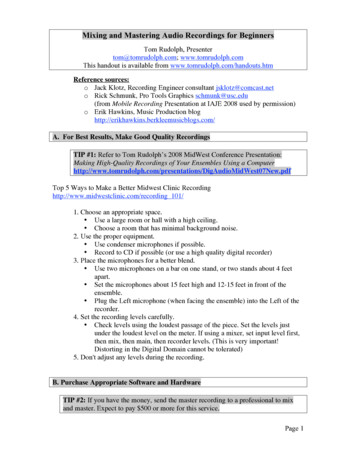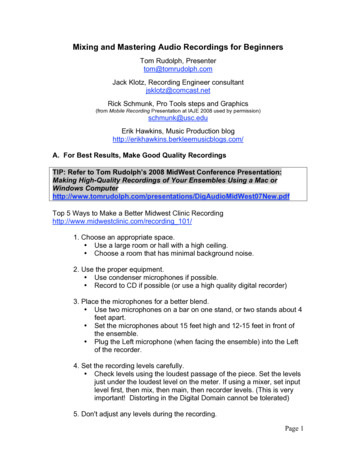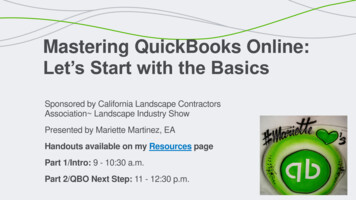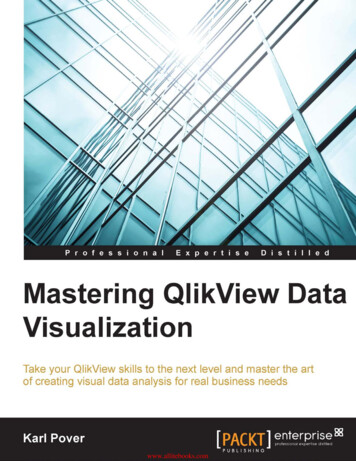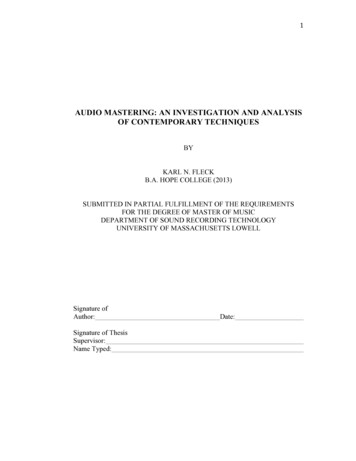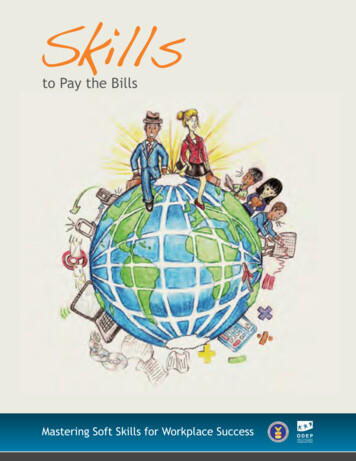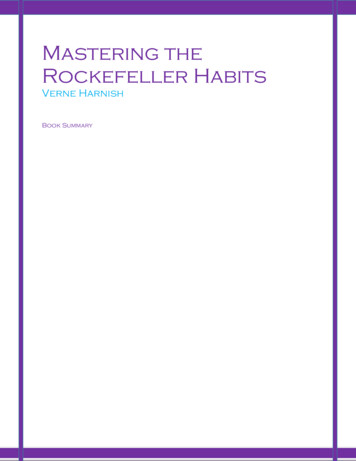
Transcription
Mastering theRockefeller HabitsVerne HarnishBook Summary
Mastering the Rockefeller HabitsVerne HarnishMASTERING THE ROCKEFELLERHABITSOVERVIEWAnyone with children will recognize the fundamentals I’ve summarized as:1. Have a handful of rules2. Repeat yourself a lot3. Act consistently with those rules (which is why you better have only a few rules)Priorities – Does the organization have objective Top 5 priorities for the year and the quarter (themonth if growing over 100% annually) and a clear Top 1 priority along with an appropriateTheme? Does everyone in the organization have their own handful of priorities that align with thecompany’s priorities?Data – Does the organization have sufficient data on a daily and weekly basis to provide insight intohow the organization is running and what the market is demanding? Does everyone in theorganization have at least one key daily or weekly metric driving his or her performance?Rhythm – Does the organization have an effective rhythm of daily, weekly, monthly, quarterly, andannual meetings to maintain alignment and drive accountability? Are the meetings well run anduseful?The “x” factor: identify the chokepoint in your business model and industry and then gain control ofthat chokepoint.--a computer on every desk and in every homeempower people through great software – any time, any place and on any deviceyou don’t have a real strategy if it doesn’t pass these two tests:o That what you’re planning to do really matters to your existing and potentialcustomers; and in second, it differentiates you from your competitionwhile other firms do things that the customer desires, but so does all the competition (you’vejust entered the commodity zone.)1. Priorities. long term Big Hairy Audacious Goal (BHAG)2. Data. Smart numbers, Critical number3. Rhythm. Until your people are “mocking” you, you’ve not repeated your message enough. Awell-organized set of daily, weekly, monthly, quarterly, and annual meetings keep everyonealigned and accountable.IMPLEMETNATION purchase a book for every executive and manager and simply go through one chapter per monthand discuss how the concepts can be applied to your firm. And several executives are purchasing a2 P age
Mastering the Rockefeller HabitsVerne Harnishbook for every employee. It’s very inexpensive training and provides the rest of the employeeswith some important context for the changes management are makingELECTRONIC FORMSDownload at www.gazelles.comCHAPTER 1: MASTERING GROWTHExecutive Summary: in their abilities to delegate and predict .systems and structures---It’s fun and we’re making money calls that 4% “gazelles”, which are firms that grow at least 20% a year for four years in a rowThe “textbook” she’s referring to are the three fundamental barriers to growth outlined in thisbook that are common among all growing firms: the need for the executive team to grow asleaders in their abilities to handle the complexity that comes with growth; and the need tonavigate the increasingly tricky market dynamics that mark arrival in a larger marketplace.“ was that if you can’t afford the people to run the business for you, hen all you have is a job,not a business. It was like somebody turning on the light for me, because I realized that Ineeded to get good people in here to do this for me. I couldn’t keep hiring people at as close tominimum wage as possible.He needed a managerial structure in place to let him focus on his real job of growing thecompanySYSTEMS AND STRUCTURES- salary, schedules, performance evaluations, information systems, and strategic planningprocessesIn the future, there will have to be more executive-level hires. “We will need their experienceand expertise, again, to help us grow and to grow our internal team.” However, next time sheplans to hire those with experience in a company with 500-1000 employees, not the megacorporationsDATA DRIVES PREDICTION---Ultimate goal – predictabilityUnless a company has the ability to determine where it is today and project where it’s going tobe this week, this month, this quarter, and this year, it’s not a trajectory for growth. It might noteven be on track for survival.McKinney’s almost slavish devotion to metrics and measurements. McKinney started bytraining his entire workforce to understand terms like “gross margin” and “cost of sales”through having the operate a lunchtime sandwich businessThe critical number tells the entire corporation, day to day, whether there’s profit headed forthe bottom line. “The idea of always measuring and tracking a Critical Number gives you a firmfoundation to know where you are – even if you don’t like the answer.3 P age
Mastering the Rockefeller HabitsVerne HarnishTOP 5 PRIORITIESMany gazelles find it useful to set priorities for each quarter – no more than five – and then toidentify one goal that supersedes the others. This is known as a Top 5 and Top-1-of-5 prioritylist.--Everybody has this four-color Top 5 and Top 1 of 5 hanging over their desks, you typically get‘Wow’ says Carney. It sends a clear indication to a clientChoosing a space motif, Carney first set a “Launch” theme and introduced it at an all-companyevent held at The Challenger Center for Space Science Education.While many companies tend to focus their themes on sales goals, it’s important to focus onother areas as well. “We tend to pick a non-sales goal in our fourth quarter each year,” says TheScooter Store’s Harrison. The practice started when he began to notice that the sales enginewas going full-tilt.o “Customer WOW” themeGet a hundred people all working on just 1 priority, instead of 27MEETING RHYTHMSOne of the most successful practices any would-be gazelle can implement is that of a daily huddle 0no more than 15 minutes per group, in a room or on a daily conference call, just to celebrateprogress towards goals or identify barriers blocking that progress.-These three Rockefeller Habits – priorities, data, and rhythm – are the key tools for handlingthe barriers that come with growth and keeping the company aligned.At 10 million and higher, CEOs often feel their attention is being pulled inside the business justwhen they most need to be focusing on what’s happening outside in the market.The plain truth is that growing a gazelle can be so painful at certain stages that many onotherwise successful CEO has looked to an exit strategy.Alan Rudy was considering either quitting or scaling back the business to a point where itmight seem fun again. took some training to work on his personal style “Today I have time to think and try things. This is my true talent – listening to what peopleneed, talking to competitors and customers, and adjusting my business accordingly. When I amfocusing solely inside the company, I cannot move the company ahead. I am much more theCEO than I was before.”BARRIERS TO GROWTHThere are roughly 23 million firms in the US, of which only 4 percent get above 1 million inrevenue.The two most important attributes of effective leaders are their abilities to predict anddelegate set a compelling vision the ability to accurately predict revenues and earnings is theultimate test of leadership from the perspective of Wall Street and the public markets.Getting others to do something as good as or better than yourself is one of the hardest aspects ofleadership, but necessary if you’re going to grow the business.4 P age
Mastering the Rockefeller HabitsVerne HarnishKeep in mind the rule that one great person can replace three good people. With the rightpeople, delegation is a four-step process to pinpoint what they are t do, create a measurementsystem for monitoring progress, provide feedback, and then give out appropriately timedrecognition and reward.--Accountability Charts: clear accountability established within an organization. All projects,line items on an income statement, priorities and processes must ultimately be owned by asingle person.It’s advisable to take the process per quarter that seems the most dysfunctional and clean it up.Processes are like garages and hallways closets, which become messed up over time andrequire regular attentionMARKET DYNAMICS--When the firm is under 10 million in revenue and just a little more focus internally onestablishing healthy organizational habits would pay off in the long run, you have a tendency tofocus mostly externally. In turn, as the organizational complexity issues start drawing theattention of the senior team inward at a time when it’s probably more important for the team tobe focused more on the marketplace.As for cash, the entrepreneur has to rely on self-funding or friends and family in the verybeginning.Between 1 million and 10 million, you add to your focus on revenue the cash concerns youhad been putting off.CHAPTER 2 – MASTERING THE RIGHT PEOPLE DOING THE RIGHTTHINGS RIGHTThere are three basic decisions an executive team must make:1. Do we have the Right People?2. Are we doing the Right Things?3. Are we doing those Things Right?THE RIGHT PEOPLEIf you go to www.containerstore.com and click on ‘Careers’, you’ll see their hiring philosophy – inessence, they firmly believe that one great person can replace three good people -They also pay their people 50 to 100 percent more than typical retailers, which can be done ifyou have proportionately fewer people. they have over 20 times the training of a normal business fewer people, paid more and given lots of training and development“Do I have the right people?” – ask yourself if you would enthusiastically rehire each person onyour team if given the opportunityWhen you have “A” players, it makes all the difference in the worldHIRING – SELLING THE VISION5 P age
Mastering the Rockefeller HabitsVerne HarnishHiring is a numbers game.This is why a firm that has established a stellar reputation in its industry (or even in aparticular town if you primarily hire locally) is able to continue to hire stellar people.Generally speaking pool of 50 high-quality people to choose from. “A” people tend tosurround themselves with “A” people, so go only to your “A” network of friends. I’m very seriousabout this last comment. make a simple Top 10 list. Take out a piece of paper and write down at least 10 people (20 isbest) you could e-mail tomorrow who have contact with the kinds of people you want. Then, puttogether a two-paragraph summary describing your firm, the position, and the kind of person youwant to hire .make it a point to call the people on your list as quickly as possible and let themknow you’re sending the summary by email. Follow-up a week later to see if they know anyone orif they at least know someone who might know someone.When was the last time you had fun at work?It’s a great time to join our promotional marketing agency team. Get all the benefits of workingwith Fortune 500 clients in a small-agency environment. Not only do we take pride in what we do,we have FUN. Your creativity and energy are what we need. PROMOTIONS MANAGER description(delineating what you’ll do) and ACCOUNT EXECUIVE description. Enjoy coming to work. Sendresume to .THE SELECTION PROCESSBradford Smart is the expert in this field. I highly recommend his latest book Topgrading. It’s very“how to”.Bigby Havis & Associates-Fit with your cultureHave a positive or negative outlookI recommend and use a variation of an assessment-center approach. Outline on a piece of paperthree or four business challenges you’re expecting candidates to face when hired and then givethem 30 minutes to an hour to work through how they would handle each. Then, spend another 30minutes working through their solutions with them to see how they think and to get a sense howyou might work together. the best way to select the Right Person is to have someone work with you for several weeks doingthe work you’re expecting him or her to do. For frontline hires, “temp-to-perm” placement firmsare popular because they allow you to test-drive the candidate. hiring people you’ve worked with in the past are so effective. Overall getting the right people inthe right positions is the first and most important job of the CEO and executive team.RIGHT THINGS MODEL6 P age
Mastering the Rockefeller HabitsVerne HarnishThe key questions on the Right Things side of the model are “Do you have a viable economicmodel?” Or, more bluntly, can you ever make real money doing what you’re doing? Do youhave a product or service that enough customer’s value to make a viable business? And haveyou determined the X factor that you can control that differentiates you from the competitionmatters to customers and provides you an advantage in the marketplace?If you then consider that a business is simply “people” doing “activities”, the model supports afamiliar notion that you lead people and manage their activities – you don’t manage people.“son, you’re good, what you did is bad” versus, “son, you’re bad.”“freeing up your future!”On the Things Right side, the organization strives to achieve three additional outcomes: doing eachof the activities better, faster, and cheaper. The primary objective is to continue to lower the costsof delivering your products or services relative to the sales price and improve the value propositionso you can maintain your prices relative to the competition to increase profitability. “buy low, sellhigh, and keep good records”ROCKEFELLER HABIT #1--Number one priority for any particular quarter Even though your firm may have issues within all six areas, you can only advance one of theareas on each side at a time. And because they are all interconnected.Leaders find that when they focus one’s energies around one area, it gets fixed much morequickly. Two visual analogies are helpful. First, think of the six circles as spinning plates onsticks, like you might have seen on an old Ed Sullivan rerun. At any one time, one of theplates of the three on either side is spinning slower than the other two and needs yourattention.(get
Verne Harnish 2 P a g e MASTERING THE ROCKEFELLER HABITS OVERVIEW Anyone with children will recognize the fundamentals I’ve summarized as: 1. Have a handful of rules 2. Repeat yourself a lot 3. Act consistently with those rules (which is why you better have only a few rules) Priorities – Does the organization have objective Top 5 priorities for the year and the quarter (the month if .



